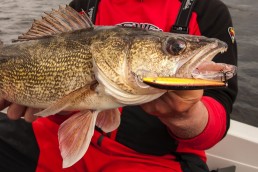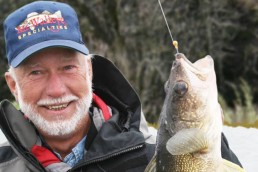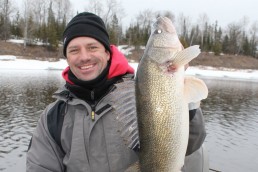SHARE THIS POST
Some of the best walleye lakes in the North and into Canada have stained water. Fishing these waters can be very different than bodies of water with clearer water. From fish behavior, where they live, how they react to your presentation and even how they react to boat traffic, is different. Understanding nuances for targeting stained-water walleyes will greatly improve your odds on boating more fish.
Stained water means the water has a tea or light coffee color to the water caused by tannins. Tannins are the byproduct of nature’s fermentation system. Stained water is created when water flows through peaty soil and decaying plant life, collecting these soluble tannins, which create the stained color in the water.
A great example is Lake of the Woods. The watershed drains from the south and flows north. Much of the watershed is bog and prime country for creating stained water both in the Rainy River and Lake of the Woods.
Having a good understanding on the preferences of stained-water walleyes will help.
Color
With darker water, there are definitely some go-to colors like gold, bronze, pink, along with bright glow colors like chartreuse, orange, glow white and glow red. Gold is popular. In fact, some who fish these and similar waters will tell you to “use any color as long as it’s gold.”
When jigging, I use a glow bubble gum with a gold jig base or a glow pink and gold jig. You really are hitting on many of the colors walleyes living in stained water love. Other options are UV colors, and one of my favorite cranks on LOW is a pink UV Firetiger Shad Rap. Having UV on jigs and blades can certainly be productive as well.
Whether we are talking jigs, crankbaits or spinner blades, having a variety of color options known to be effective in stained water can help your cause. Rotate colors until you dial in to what they want that day.
Scent
Scent can be a huge advantage when fishing walleyes in waters not so clear. Frozen emerald shiners are a staple as baits in these parts, and for good reason—they just work. The strong smell combined with the shiny silver scales are desired by LOW walleyes. A fresh lively minnow certainly has its place. In addition to the smell, each twitch of the minnow is detected by the walleye’s lateral line and can be enough to encourage them to feast.
There is a period of time in the summer months when a lively leech on a jig can be the ticket. Again, a different scent, great action and something a bit out of the ordinary, is important. Fresh ‘crawlers pulled behind a ‘crawler harness also has good scent the walleyes like. I pinch off a bit of the ‘crawler so I don’t have too much hanging off of the last hook. The walleyes will still hit the harness, but with a pinched-off shorter offering there is more scent and my hooking percentage is better.
Some anglers add scent to their crankbaits. Adding a small piece of ‘crawler to the front treble hook, as long as it doesn’t mess up the action of the crank, can be effective. Others douse their favorite crankbaits in their favorite liquid scent.
Are you enjoying this post?
You can be among the first to get the latest info on where to go, what to use and how to use it!
Noise and vibration
Creating noise in stained water is effective. Vibration triggers the walleye’s lateral line and is effective in most bodies of water. It seems like it’s even more important when a fish’s sight is diminished by the color of the water and they have to rely even more on their lateral line. When jigging, walleyes don’t seem to be as finicky as in clearer water. I often hear, “Use the lightest jig the conditions allow.” On Lake of the Woods, due to the color of the water, a larger jig is not only acceptable, but also preferred. The larger jig head and bigger thump when it hits the bottom are welcomed by walleyes. It also makes it easier for anglers to have control of their offering in deeper water or in wind.
A jig with a spinner of some type adds vibration and can make a difference. Jigs such as a whistler jig with a propeller or a jig with a spinner on the back adds enough noise to sometimes attract walleyes that may not otherwise be as interested. When jigging the Rainy River, some use plastics to increase the odds of a walleye taking their offering. Ribs on the plastic, a twister tail or paddle tail in the current, can add that extra noise walleyes are looking for.
When it comes to crankbaits and vibration, it’s good to mix it up until you figure out what the fish want. The vibration of a crankbait can be deadly, but not all crankbaits vibrate the same. The size and shape of the crank, type of wobble, straight or jointed, all effect vibration. If you’re fishing with a partner, start out using different types of cranks until you get them dialed in.
Pulling ’crawler harnesses in stained water is effective; the spinning blade adds vibration and good flash. In stained water, don’t be afraid to upsize your blade for increased vibration. The “thump, thump, thump” of a big number 5 or 6 deep-cup Colorado blade can be tough for big walleyes to ignore.
Another advantage when fishing stained water is having a tint to the water, which can actually make the walleyes bite more during daylight hours verses the conditions for a night bite. For some who either aren’t early risers or don’t like being on the water after dark, these low-light conditions aren’t so critical to producing a nice batch of walleyes.
Walleyes are less spooky in stained water too. One of the go-to methods of charter boats on Lake of the Woods is to anchor up and jig right below the boat. It could be anywhere from 7 to 30 feet of water, and the walleyes don’t seem to mind. In many cases, it almost seems like a mini-ecosystem is created under the boat. A combination of fish activity, the smell and flash of frozen shiners, bait that falls off the hook and fighting walleyes on the end of the line all add activity.
When pulling cranks, it is rare to use a planer board on Lake of the Woods. Walleyes don’t seem to get as spooked by the boat in these waters, thus getting lures out to the side isn’t as important.
When pulling harnesses, often I pull a 2-ounce bottom bouncer with a harness in 5 feet. My harness is practically in the prop wash of my kicker motor, and the walleyes crush it. On one occasion while fishing a tournament, I had nice walleyes going in 4-6 feet pulling harnesses. I wondered what might happen if I pulled up my kicker motor and just used my bow-mount trolling motor to have more stealth. I actually caught fewer walleyes and went back to the kicker and started catching more fish again.
Stained-water lakes like Lake of the Woods are some of the best walleye lakes around. Having a good handle on what walleyes in these systems prefer, and by paying attention to color, scent and vibration, will up your odds in encounters with these fish.
MWO
SHARE THIS POST
Did you enjoy this post?
You can be among the first to get the latest info on where to go, what to use and how to use it!
Joe Henry
Tournament angler and licensed charter captain Joe Henry fishes and hunts the Midwest. Henry is a media member of AGLOW and writes for numerous publications, creates videos, appears on a variety of outdoor TV and radio shows and is a frequent seminar speaker. Henry is the Executive Director of Lake of the Woods Tourism.



